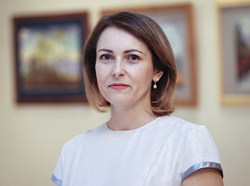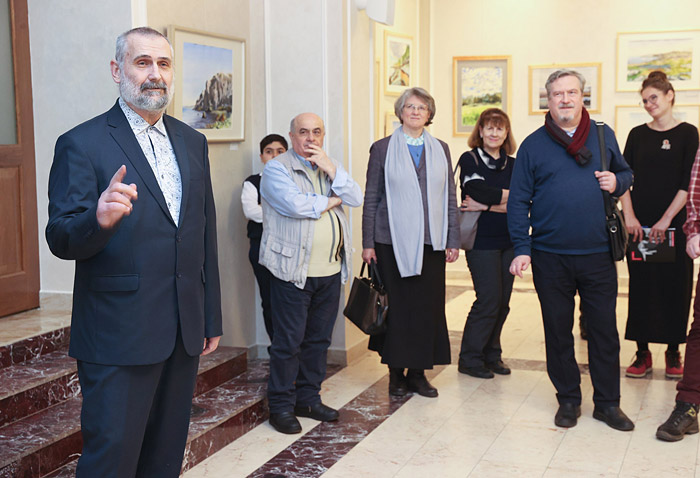
Electronic english version since 2022 |
The newspaper was founded in November 1957
| |
|
Number 13 (4610)
|
Our vernissage
"To leave a freedom for watercolour..."
 Lake Ladoga, Arkhangelsk, Murmansk, Teriberka, the coasts and islands of the White and Barents Seas - not every Russian has traveled so far north of our homeland. A Slovak artist Maria Bali has been in these places more than once. "A magical landscape, strong and boundless," writes Maria in the abstract for the exhibition, "Rough and beautiful at the same time, full of contrasts, harmoniously leading a person to catharsis. And I will try to reveal this symbiosis in my artworks. Every year I return to the Russian North with excitement and expectation of new impressions..."
Lake Ladoga, Arkhangelsk, Murmansk, Teriberka, the coasts and islands of the White and Barents Seas - not every Russian has traveled so far north of our homeland. A Slovak artist Maria Bali has been in these places more than once. "A magical landscape, strong and boundless," writes Maria in the abstract for the exhibition, "Rough and beautiful at the same time, full of contrasts, harmoniously leading a person to catharsis. And I will try to reveal this symbiosis in my artworks. Every year I return to the Russian North with excitement and expectation of new impressions..."
Watercolour is a special, organic technique for me - it participates in the process of creation. One may partially affect the process how and where the paint will "float" on paper, but it is much more interesting to understand how it works and use it for the benefit of the artwork. To leave a freedom for watercolour to create unique fills. That's when this beautiful, unique charm occurs - exceptional lightness and naturalness. Watercolour…"
"I can't believe that the North is in the paintings, they are so sunny, bright ..."
"No matter how many times we have been in the North, and that's already three times we have been there, each time it was sunny and warm, the temperature rose to 30 degrees. All in all, it rained only 2 or 3 times in 6 weeks."
"Did you go there on vacation?"
"No, just for the plein air."
"And why to the North?"
"I saw the photos of these places, they attracted me magically."
"There is nothing like the Russian North in Slovakia," adds Jan Busa Jr., Maria's husband, who helped me with the translation. "We often traveled to the south of Europe, but there is nothing like the Russian North in Slovakia, it is very unusual."
"Are you an artist by training?"
"I studied architecture, first as a landscape architect, then I defended my thesis in architecture. During my studies, I constantly had to draw by hand, because such a drawing is much more valuable than the one made on a computer. Once we had an opportunity to go on a plein-air trip to the North and we liked it so much that now we are looking for any chance to go there again.
When I worked as a landscape architect, my specialty was to bring the natural landscape into the city. I wanted the city to become one with the surrounding nature. I love looking at landscapes, to feel what is called the genius of a place and somehow transfer it into the city. To unite the nature around with what is inside the city."
"Have you implemented any architectural projects in Slovakia?"
"Yes, but then I had a break for the birth of my two children and here I began to paint."
"Do you work only in watercolour or do you use other techniques as well?"
"Watercolour and pastel. I like that I can quickly capture what I see. Half an hour has passed - and everything has changed, the lighting, the nature itself, there are big ebbs and flows in the North, the landscape of the coast changes a lot - just before there were rocks and the next moment everything is already hidden by water. And no other technique will allow you to quickly capture the bright moment, to catch the moment."
Opening the exhibition, MLIT Assistant Director for International Cooperation and Human Resources Edik Hayryan began his speech by reminding us that over the past two difficult years the JINR Cultural Centre "Mir" has not stop its activities, although it has not been easy. "I know this family of physicists and mathematicians. Maria has brought lyrics to it," Edik Hayryan noticed. "Maria has been living in Dubna for almost five years, she has never been to Russia before," MLIT Deputy Director for Scientific Work J?n Bu?a noted. "For five years she has become accustomed to life here, as well as feels at home here. I have seen all the exhibited paintings before, but the ones on the walls look completely different. They were painted in Murmansk, on the southern shore of the White Sea, on Ladoga. I envy the guys, I haven't been there. I want to thank the director of the Cultural Centre for the opportunity."

JINR Assistant Director Samvel Harutyunyan congratulated Maria on a wonderful exhibition: "Once I used to paint and I can say that watercolour is a complex technique and Maria has achieved obvious success. You are definitely a talented person!" Head of the JINR International Cooperation Department Dmitry Kamanin noted, "We often use the formula "Science brings nations together", but today we can say that art brings nations together. The opening of this exhibition is a great opportunity for our international family to gather here. And let the same peace reign in our souls, as in these paintings."
There was a live music at the vernissage: students of the Dubna Children's Music School, pianist Vincent Gasparyan (tutor L.Akopyan) performed a waltz from A.Khachaturian's music to M.Lermontov's drama "Masquerade" and Matilda Busha on the balalaika (tutor G.V.Dementeva) - " Dancing tune" by V.Feoktistov and a minuet by J.S.Bach. Together with Maria Bali this holiday was shared by JINR staff members from Armenia, Slovakia, Russia, as well as people of Dubna. The exhibition will be available until 9 May.
Olga Tarantina,
photo by Igor Lapenko